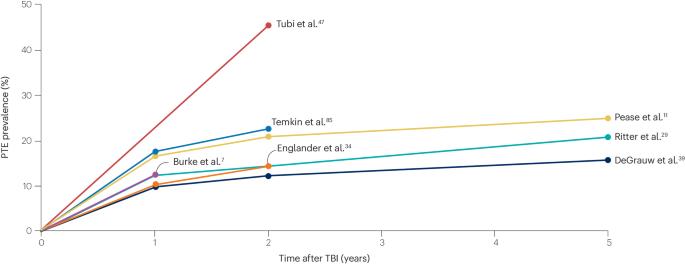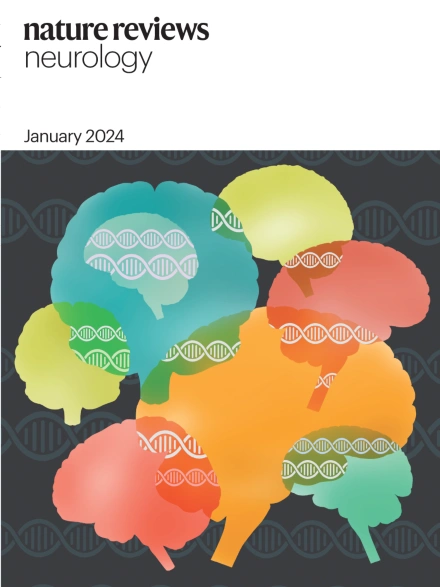创伤后癫痫对癫痫发生的启示
IF 28.2
1区 医学
Q1 CLINICAL NEUROLOGY
引用次数: 0
摘要
创伤后癫痫(PTE)占所有癫痫的 5%。创伤性脑损伤(TBI)后 PTE 的发病率取决于损伤的严重程度,在损伤最严重的群体中,发病率接近三分之一。PTE 的特点是反复发作,会损害神经系统的恢复,增加创伤性脑损伤后出现不良后果的风险。鉴于这种反复发作的高风险和受伤后相对较短的潜伏期,PTE 成为了解人类癫痫发生和试用新型抗致痫疗法的模型疾病。癫痫发生是指原本正常的脑组织容易反复出现异常电活动,最终导致癫痫发作的过程。在本综述中,我们将描述 PTE 的临床过程,并重点介绍利用 PTE 动物模型对癫痫发生和治疗进行的前景广阔的研究。目前正在开发临床、成像、脑电图和体液生物标记物,以帮助识别可能受益于抗致痫疗法的 PTE 高危患者。对 PTE 临床前模型的研究已经确定了可能预防癫痫的可控途径和新型治疗策略,但仍有待在人体中进行验证。除了改善创伤性脑损伤后的预后外,PTE 研究的进展还可能提供与所有癫痫相关的治疗见解。本文章由计算机程序翻译,如有差异,请以英文原文为准。

Insights into epileptogenesis from post-traumatic epilepsy
Post-traumatic epilepsy (PTE) accounts for 5% of all epilepsies. The incidence of PTE after traumatic brain injury (TBI) depends on the severity of injury, approaching one in three in groups with the most severe injuries. The repeated seizures that characterize PTE impair neurological recovery and increase the risk of poor outcomes after TBI. Given this high risk of recurrent seizures and the relatively short latency period for their development after injury, PTE serves as a model disease to understand human epileptogenesis and trial novel anti-epileptogenic therapies. Epileptogenesis is the process whereby previously normal brain tissue becomes prone to recurrent abnormal electrical activity, ultimately resulting in seizures. In this Review, we describe the clinical course of PTE and highlight promising research into epileptogenesis and treatment using animal models of PTE. Clinical, imaging, EEG and fluid biomarkers are being developed to aid the identification of patients at high risk of PTE who might benefit from anti-epileptogenic therapies. Studies in preclinical models of PTE have identified tractable pathways and novel therapeutic strategies that can potentially prevent epilepsy, which remain to be validated in humans. In addition to improving outcomes after TBI, advances in PTE research are likely to provide therapeutic insights that are relevant to all epilepsies. Post-traumatic epilepsy is a major driver of disability associated with traumatic brain injury. This article reviews the epidemiology and clinical features of post-traumatic epilepsy and discusses how an understanding of the underlying epileptogenic mechanisms might inform the development of anti-epileptogenic medications.
求助全文
通过发布文献求助,成功后即可免费获取论文全文。
去求助
来源期刊

Nature Reviews Neurology
医学-临床神经学
CiteScore
29.90
自引率
0.80%
发文量
138
审稿时长
6-12 weeks
期刊介绍:
Nature Reviews Neurology aims to be the premier source of reviews and commentaries for the scientific and clinical communities we serve. We want to provide an unparalleled service to authors, referees, and readers, and we work hard to maximize the usefulness and impact of each article. The journal publishes Research Highlights, Comments, News & Views, Reviews, Consensus Statements, and Perspectives relevant to researchers and clinicians working in the field of neurology. Our broad scope ensures that the work we publish reaches the widest possible audience. Our articles are authoritative, accessible, and enhanced with clearly understandable figures, tables, and other display items. This page gives more detail about the aims and scope of the journal.
 求助内容:
求助内容: 应助结果提醒方式:
应助结果提醒方式:


